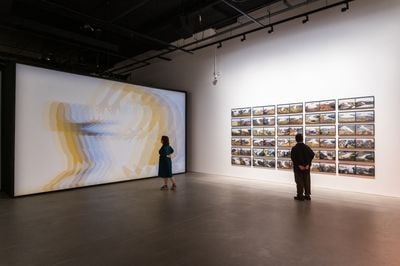Olafur Eliasson: Your curious journey
Singapore Art Museum, 39 Keppel Road
10 May–22 September 2024
Expect: sensory installations that incorporate light, water, and fog to reflect on perceptual phenomena and the impact of climate change.
Icelandic-Danish artist Olafur Eliasson presents his first survey to tour Asia-Pacific. The exhibition covers three decades of Eliasson's practice working with natural elements—such as light, colour, water, and movement—that invite viewers to look at their surroundings anew.
The installation Beauty (1993), for instance, stages a curtain of mist inside a dark gallery by illuminating water dripping from a punctured hose with white light. A rainbow appears on the water's surface, at once inspiring awe and prompting contemplation of this fabricated phenomenon.
Eliasson grew up amid Iceland's natural landscapes. His series 'The glacier melt series 1999/2019' (2019), also on view, captures the titular ecological catastrophe with comparative photographs from 1999 and 2019. Likewise, The last seven days of glacial ice (2024) is a group of sculptures that traces the stages of a melting ice block Eliasson found on a local beach.
After Singapore, the exhibition will travel to Auckland Art Gallery Toi o Tāmaki, New Zealand; Taipei Fine Arts Museum, Taiwan; Museum MACAN, Jakarta, Indonesia; and Museum of Contemporary Art and Design, Manila, Philippines, concluding in 2026.
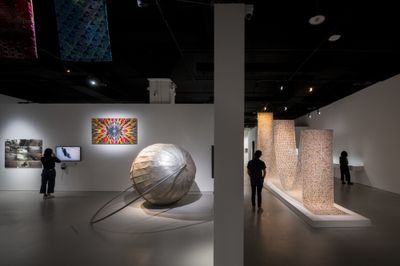
Exhibition view: Everyday Practices, Singapore Art Museum at Tanjong Pagar Distripark (30 August 2024–20 July 2025). Courtesy Singapore Art Museum.
Everyday Practices
Singapore Art Museum, 39 Keppel Road
30 August 2024–20 July 2025
Expect: works by 20 artists and collectives that explore how everyday actions can become gestures of resistance.
Everyday Practices inquires into how artists across generations have confronted the challenges of everyday life—including its repetitive nature and corresponding adversities—in their work.
The title borrows from performance artist Hsieh Tehching's seminal work, One Year Performance (1978–1979), for which he spent an entire year inside a prison cell built inside his New York studio to convey the alienation he felt in the United States as an undocumented immigrant.
Works on view—by artists such as Htein Lin, Tan Guo-Liang, and Apichatpong Weerasethakul—will address conflict, humanitarian crises, and asymmetrical power relationships. Together, they seek to answer the question: 'In the face of life's challenges, how do we go on going on?'.
Dusadee Huntrakul, for instance, is known for his attention to different life forms, which he casts in clay, often subverting human hierarchies of importance to present alternative value systems.
Gecko droppings—a familiar sighting in his Bangkok studio—commonly surface in his ceramics. 'They do represent this kind of wilderness that is beyond us,' Huntrakul told Ocula Magazine, noting that his work with faeces is ultimately about consumption and cycles of generation.
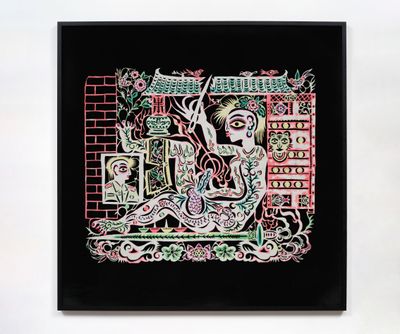
Xiyadie, Sewn《縫》 (1999). Papercut with water-based dye and Chinese pigments on xuan paper. 174.5 x 174.5 x 5 cm (framed). Courtesy the artist and Blindspot Gallery.
Black Box 黑匣
Ames Yavuz, 9 Lock Road
29 August–12 October 2024
Expect: works by 12 artists from mainland China responding to the themes of imprisoned bodies and spatial boundaries.
Referring to a place devoid of light, Black Box features work by 12 Chinese artists made in response to what Beijing-based curator Yang Zi refers to in the exhibition literature as an individual's 'struggle for liberation' when confronting a state of darkness.
By definition, a black box is a system that generates legible results from complex processes. Here, however, it perhaps serves as a metaphor for mainland China's political apparatus, which filters information both circulating within and entering/exiting the country, with the selected works suggesting different ways to break free.
Beijing-based Zheng Yuan, who works primarily in video, is known to inquire into how images can shape perceptions of contemporary Chinese society. Filmed during lockdown in the capital in 2022, What Is To Be Done? (2023)—a person clearing household objects inside an apartment until they are no longer within view—nods to how limited access to information can distort people's understanding of their surroundings.
The works in Black Box reflect Zi's belief that, in the battle for freedom, sometimes bodies must 'forfeit their original structures'. Yet, ultimately, it is language itself, with metaphor and allegory as its conduits, that casts light amid obscurity.
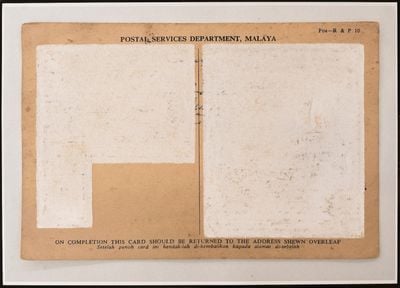
Wei Leng Tay, 3 Nam Lock Street, Singapore (no.1) (2024). Archival pigment print. 42.0 x 59.4 cm. Edition 1 of 2 plus 1 AP. Courtesy the artist.
Wei Leng Tay: Staring into Voids and Blues
Yeo Workshop, 47 Malan Road
14 September–20 October 2024
Expect: an image-based inquiry into Singapore's public and private histories drawing on the artist's family archive.
Artist and photographer Wei Leng Tay—whose family migrated from China to Malaya to multicultural Singapore—understands photography's limitations in transmitting an accurate portrayal of identity and history.
Exploring this partial Chinese identity and the fallibility of human recollection, her work often uses formal strategies such as abstraction, layering, and fragmentation to reflect on how images are made and to call attention to what is omitted.
At Yeo Workshop, the artist's recent photographic prints and installations build on her interests in migrant communities and photography's ability to accurately convey the past. Works on view draw on her family archives to reflect on Singaporean society today.
3 Nam Lock Street, Singapore (no.1) (2024) is a photographic print of a document from Malaya's postal service, the contents of which have been redacted. The title refers to a now-expunged street in Singapore that once led to Kampong Bugis, an area which housed a vibrant community during the country's industrialisation in the late 20th century.
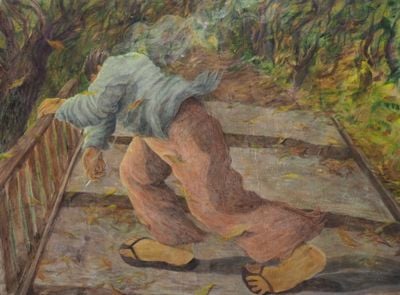
Faris Heizer, Hold On (2024). Acrylic on linen. 146 x 200 cm. Courtesy Cuturi Gallery.
Faris Heizer: The Man Who Eventually Moved
Cuturi Gallery, 61 Aliwal Street
14 September–19 October 2024
Expect: narrative paintings that capture the existential despair of life under the weight of routine, stillness, and the comfort of mundanity.
Figurative painter Faris Heizer renders gripping observations of contemporary Singaporean society and the residual feelings that result from living within the country's capitalist structures, which can incite anything from anxiety to ennui, dread to despair.
Heizer is adept at conveying his characters' inner worlds. His expressive brushwork builds up compelling scenes in oneiric palettes of purples and greens, while the body language of his subjects relays their existential reckoning.
A young man with slumped shoulders ambles along on his commute, worn-out leather shoes tied by their laces and strung around his neck (Heavy Shoes, 2023). Another stands on a bridge in the pouring rain: his shirt has been removed and both arms rest on the other side of the railings as he looks down to the passing traffic below (There Should Be Sunshine After Rain, 2023).
In the artist's latest work, these sentiments are amplified against the mundanity of daily existence, as simple moments—a man sits with a glass of wine outside (Birdsong, 2024)—are swallowed by the threat of indefinite duration. Painting itself turns into a gesture of resistance.
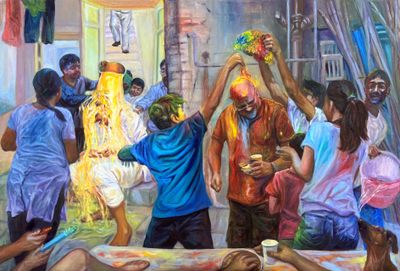
Rajesh P Kargutkar, Colour Day (2024). Oil on canvas. 60 x 90 cm. © the artist. Courtesy the artist and The Culture Story.
Rajesh P Kargutkar: Cramped Space
The Culture Story, 2 Leng Kee Road
27 July–2 October 2024
Expect: autobiographical paintings that present a view into Mumbai's migrant housing complexes.
Rajesh P Kargutkar's latest series unfolds the myriad lives residing in Mumbai's chawls: dense tenement complexes that provided low-cost housing to economic migrants in the 19th century. Rather than depicting the Cramped Spaces of the exhibition title, however, Kargutkar offers a playful and inviting view of the local community.
On a busy stairwell, a parrot flies into a man's face, sending him tumbling, while another resident, glacially white, bends over under a line of clean clothes in an attempt to conceal his naked body (Welcome, 2023–2024). A young girl sits on the floor holding a container for change.
Kargutkar humanises his subjects by portraying them in bright garments amid lively surroundings, filled with laughter and community. Works such as Colour Day (2024) show residents engaged in comical or playful intergenerational activities, providing viewers with an abundant perspective on the artist's hometown.

Lin Aojie: Playing it Safe in 2023, Praying for Wealth in 2024
ShanghART Singapore, 9 Lock Road
7 September–10 November 2024
Expect: recent works that share the artist's insights on the art industry, geopolitics, and the human condition.
Lin Aojie's first exhibition in Southeast Asia gathers different works that express the young Chinese artist's view on the international art world and its relationship to the artist—one that is intrinsically tied to global dynamics and power relations in society.
As a parallel, Lin reimagined 19th-century writer Tse Tsan-tai's political cartoon, The Situation in the Far East (时局图), depicting Western powers moving into China as the iPad painting, Southeast Asia Art Scene. In Tse's version, a bear, symbolising Russia, charges from the north. A bald headed eagle arrives from the Philippines, then occupied by the U.S.
References to history as a mirror into the present is common in Lin's work, conceived mostly from digital mediums. A hidden video, Ultimate Super Dodgy Talk (2024), comments on desire and human nature, its insights revealed to those who bother to venture into the gallery. —[O]
News Source


